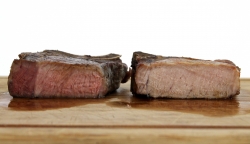

When cooking pork on the stove-top, general wisdom holds that the pork must be cooked to at least 145ºF — if not higher — to kill any food-borne pathogens. The problem with cooking lean cuts of pork, like bone-in rib chops, to that high of a temperature is that the meat will dry out. Plus, if you want to cook a thick rib chop, it is close to impossible to bring the center to the proper temperature without over-cooking the exterior. Precision cooking eliminates the problem. When using the Anova Precision Cooker at a relatively low temperature, you can still prepare the pork safely. How? By extending the cooking time. A long cooking time will essentially pasteurize the pork, rendering it safe to eat, even when cooked medium or even medium-rare. Take a look at the difference: the pork chop on the left has been cooked en sous vide at 140ºF for 2 hours, and it is gloriously pink from edge to edge. Its muscle fibers are tender and full of juice. (If you’d like a medium-rare chop, you could even cook the pork to 135ºF; just give it an extra 30 minutes in the water bath.) The pork chop on the right, on the other hand, was seared on the stove-top and transferred to a hot oven until it registered 145ºF. Its internal temperature climbed even higher, up to around 150ºF, after resting. It is not completely dry in the center, but the edges are overcooked and the muscle fibers have constricted and become less tender.
Kate Itrich-Williams